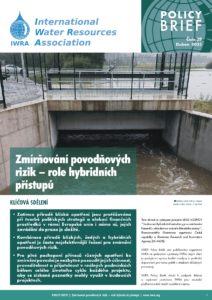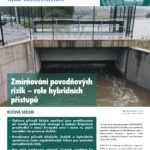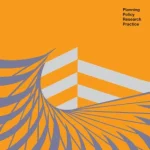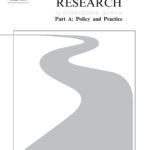

Policy Brief – Flood Risk Mitigation – The Case for a Hybrid Approach
The publication explains the terminology of flood risk mitigation measures – especially differences among green and hybrid measures.
This article presents a summary for key stakeholders in the water sector, prepared in collaboration with the International Water Resources Association (IWRA), and presents key recommendations based on the current knowledge on flood risk mitigation through hybrid approaches. These recommendations are:
• While nature-based approaches are gaining traction in policy and funding priorities within the European Union and beyond, their implementation is complex.
• Combining nature-based, grey, and hybrid flood risk measures can often offer the most effective mitigation of flood risk.
• To fully understand the benefits of various flood mitigation measures, their effectiveness, feasibility, and acceptability must be assessed in real-world settings throughout each project’s lifecycle to inform future projects.
Citace: Slavíková, L., Raška, P., Bezak, N., & Čermáková, N. (2025). Policy Brief – Flood Risk Mitigation – The Case for a Hybrid Approach. IWRA – International Water Resources Association. n. 29.
Studie: ↓ Flood Risk Mitigation – The Case for a Hybrid Approach
OKliBio: Fruit Landscapes for Climate Protection and Biodiversity
 |
Protection of meadow orchards and fruit tree alleys supporting biodiversity, the cultural heritage of our landscape, old varieties, and the sustainable development of agricultural landscapes.
The project focuses on improving green infrastructure through the maintenance of orchards and orchard lanes, which play a crucial role in protecting biodiversity. These habitats provide a refuge for many species and preserve old fruit varieties with valuable genetic information. Unfortunately, many new plantations suffer from poor management and the spread of invasive species. The project aims to promote sustainable management and restore the ecological value of these habitats.
A key element of the project is cross-border cooperation between Northern Bohemia and Saxony, based on the historical and ecological links between the regions. The outcome will be a bilingual knowledge database containing information on meadow orchards, varieties and their distribution. This database will support the exchange of expertise, the transfer of best practices and the sustainable use of the landscape. The project will also analyse the benefits of orchards through ecosystem services and involve landowners and other stakeholders.
An integral part of the project is fruit processing and support for regional supply chains, which can contribute to the long-term sustainability of meadow orchards. The focus is on economic viability and the promotion of traditional fruit growing that supports biodiversity and local communities. The project combines ecology, tradition and sustainable development to protect the natural heritage and create healthier landscapes.
IEEP is responsible for assessing the benefits of meadow orchards in the landscape using the concept of ecosystem services, evaluating biodiversity and identifying landowners’ motivations and barriers to planting and maintaining fruit trees.
| Funding Agency: | Interreg Česko – Sasko 2021-2027 |
| Duration: | 1/2025 – 12/2027 |
| Contact person: | Lenka Dubová, e-mail: dubova@ieep.cz |
| Researchers: | Jiří Louda, Marek Hekrle and others |
| In cooperation with: | Leibniz Institute of Ecological Urban and Regional Development (Germany; Lead Partner)
Czech Union for Nature Conservation (ČSOP, Czech Republic) Landschaftpflegeverband Sächsische Schweiz-Osterzgebirge e.V. (Germany) |
| Project budget: | 1.157.687,35 EUR |
| ERDF funding: | 926.149,87 EUR |
| Web-site: | https://stareodrudy.cz/Stareodrudy/Projektyuvod?prkai=34 |
SpongeBoost: Upscalling the natural sponge functions of freshwater ecosystems to deliver multi- benefit green deal solutions
How to support sponge functions of freshwater ecosystems in the form of wetlands and other nature-based solutions
A consortium of 10 partners from a total of 7 different European countries aims to find, compile and test innovative solutions to increase the potential of the sponge function of the landscape, especially wetlands. Due to the impacts of climate change, it is essential to find ways to preserve or restore key ecosystem functions and features in the landscape. The main aim of the project is to develop a roadmap to support the further implementation of these measures based on all the evidence from existing research around the world, as well as the results of its own investigations and pilot case studies. In addition to the natural and technical aspects, attention will also be given to economic, social and regulatory aspects and to finding business models that will provide funding for the implementation of wetlands and other nature-based solutions beyond existing subsidies in the form of alternative innovative models.
The IEEP team is responsible for leading one work package and is also significantly involved in the implementation of institutional analysis, barrier analysis and the design and validation of innovative business models.
| Funding Agency: | Horizon Europe |
| Duration: | 1/2024 – 12/2027 |
| Contact person: | Jan Macháč, e-mail: machac@ieep.cz |
| Researchers: | Jan Macháč, Jan Brabec, Lenka Slavíková, Jiří Louda, Marek Hekrle, Lenka Zaňková |
| In cooperation with: | Helmholtz Zentrum für Umweltforschung
Wetlands International-European Association a další partneři |
Our new international research projects on climate change adaptation measures
Our team started addressing two international projects in 2023 focusing on hybrid and nature-based measures to reduce damages caused by natural disasters. We concentrate on analyzing barriers to the implementation of these measures and their effectiveness. More about the projects: Horizon Europe LAND4CLIMATE and the Czech-Slovenian project GAČR Lead Agency.
Evaluation of hazard-mitigating hybrid infrastructure under climate change scenarios
What are hybrid measures for mitigating complex natural risks? How to model their impacts and demonstrate their effectiveness?
The project will critically assess hybrid infrastructure as a promising option for adapting to climate change, serving as a more effective alternative to conventional gray and green measures. The project will focus on studying floods, soil erosion, slope movements, and other complex risks. The goal is to identify effective hybrid measures that can successfully address multiple risks. The effects of hybrid infrastructure will be evaluated through environmental modeling in various scenarios of climate change.
| Funding Agency: | GAČR Lead Agency |
| Duration: | 1/2023 – 12/2025 |
| Contact Person: | Lenka Slavíková, e-mail: slavikova@ieep.cz |
| Researchers: | Lenka Slavíková, Jiří Louda, Jan Macháč, Pavel Raška, Martin Dolejš |
| In cooperation with: | University of Ljubljana |
| Web-site: |
LAND4CLIMATE: Utilization Of Private Land For Mainstreaming Nature-Based Solution In The Systemic Transformation Towards A Climate-Resilient Europe
How to implement and validate nature-based solutions (NBS) on private land to reduce concurrent climate change risks?
LAND4CLIMATE aims to deploy and demonstrate the implementation of nature-based solutions (NBS) on private land. NBS are inspired by nature or natural processes. They promise to enhance the resilience of landscapes and urban settlements. However, the implementation of NBS is still in its infancy, especially as these measures require a fair amount of land that is often privately owned. The main objective of LAND4CLIMATE is to co- design and validate NBS on private land.
| Funding Agency: | Horizon Europe |
| Duration: | 9/2023 – 8/2027 |
| Contact person: | Lenka Slavíková, e-mail: slavikova@ieep.cz |
| Researchers: | Lenka Slavíková, Jan Macháč, Pavel Raška, Michaela Štěbetáková, Lenka Dubová |
| In cooperation with: | TU Dortmund, město Krásná Lípa, Správa národního parku České Švýcarsko and other partners. |
| Web-site: | https://land4climate.eu/ |
Mitigation of Concurrent Flood and Drought Risks Through Land Modifications: Potential and Perspectives of Land Users
The systematic review on land modifications for the flood and drought risk mitigation and motivations of land users to undertake these modifications.
Abstract: Modifications to land can serve to jointly reduce risks of floods and droughts to people and to ecosystems. Whether land modifications are implemented will depend on the willingness and ability of a diversity of actors. This article reviews the state of knowledge on land modification use in areas exposed to dual hydrologic risks and the land owners, managers, and users who directly make decisions about action on lands they control. The review presents a typology of land modifications and explains how land modifications interact with the hydrological cycle to reduce risks. It then addresses the roles and perspectives of the land owners, managers, and users undertaking land modifications, summarizing theories explaining motivations for, as well as barriers to and enablers of, land modification implementation. The analysis reveals geographical differences in narratives on land modifications as well as knowledge gaps regarding variation across actors and types of land modifications.
Citation: Slavíková, L. a Milman, A. (2023). Mitigation of Concurrent Flood and Drought Risks Through Land Modifications: Potential and Perspectives of Land Users. Annual Review of Environment and Resources 2023, 48:1, 319-346. https://doi.org/10.1146/annurev-environ-110922-031849
Carsharing users’ behaviour and attitudes. The role of car availability in households
The article is devoted to the contribution of carsharing to pro-environmental behavior – it compares carsharing users who have their own car and those who do not.
Abstract: This paper provides insights into differences in carsharing users’ attitudes, motives for joining carsharing, and transport behaviour between users with and without another car at their disposal. It builds on revealed and stated data about members of the oldest carsharing company in the Czech Republic. Carsharing adopters without a car utilise shared cars more intensively than carsharing users with a car available in their household. On the other hand, unlike the second group, they drive fewer kilometres by car in total. The car availability in households also influences the shift in car use after joining carsharing. The sale of a car thanks to adopting carsharing is a factor leading to a decrease in overall car use. Those who have a car at their disposal within their household have a lower probability of decreasing kilometres driven after joining carsharing. Households without an additional car available seem to be less car-dependent on average than those utilising carsharing as a second or third car. They tend to be more environmentally conscious and more inclined towards policies supporting alternative modes and restricting private car use, although both groups share these beliefs. The findings open a debate over whether carsharing increases the legitimacy of restrictive transport measures against private car ownership and use.
Citation: Vejchodská, E., Brůhová Foltýnová, H. & Rybičková, A. (2023). Carsharing users’ behaviour and attitudes. The role of car availability in households. Transportation. https://doi.org/10.1007/s11116-023-10386-0.
Download: ↓ Carsharing users’ behaviour and attitudes. The role of car availability in households.
Will COVID-19 accelerate telecommuting? A cross-country evaluation for Israel and Czechia
The article investigates the effects of the COVID-19 pandemic on commuting and working from home and whether the effects differed between Czechia and Israel.
Abstrakt: The COVID-19 crisis has forced many people to work from home, rather than at their regular workplace. This paper aims to assess the impact of the pandemic on telecommuting and commuting behavior after the end of the crisis: Will people embrace teleworking and reduce commuting, even to some extent, or will they resume their pre-pandemic work patterns? This study, implementing a cross-country survey from Israel and Czechia, combines data regarding revealed preferences about work habits before and during the pandemic and stated intentions data regarding anticipated work patterns when life returns to “normal” after the pandemic. Two models were used for the data analysis, one addressing factors that affect the increased/decreased teleworking trend and the other addressing factors that affect the frequency of actual commutes. The results reveal that most respondents (62% in Israel and 68% in Czechia) will maintain the same telecommuting/working from home balance. About 19% of respondents in both countries expressed their intention to reduce the number of commuting days, while 6% stated they would increase out-of-home days. However, these estimates rely only on workers’ expectations not accounting for employers’ point of view and other constraints they may have. Not accounting for potential bias, a moderate reduction of 6.5% and 8.7% (in Israel and in Czechia, respectively) in the number of commuting trips is expected in the post-pandemic era. The anticipated decrease in commuting days is accompanied by an increase in teleworking: from 10% to 14% among those who work more than 20 h a week (in both countries) and a drop in the rate of those who telework five hours or less a week (down from 73% to 63% in Israel and from 76% to 70% in Czechia). Self-employment, travel time to work, working solely on premise during the lockdown, and personal preferences regarding telework versus working away from home were found to significantly contribute to a decrease in the number of commuting days and to an increase in teleworking. An interesting finding is the high probability of increased teleworking among people who teleworked for the first time during the lockdown or who increased their teleworking time during the lockdown. This indicates that the teleworking experience due to the pandemic has enabled some people to view working from home as viable. Although, overall, the change in working habits does not seem dramatic, our results suggest that hybrid schemes for combining on premise and telework are expected to be adopted by some sectors.
Citation: Kogus A. et al. (2022). Will COVID-19 accelerate telecommuting? A cross-country evaluation for Israel and Czechia. Transportation Research Part A: Policy and Practice, 164 (2022), pp. 291-309, https://doi.org/10.1016/j.tra.2022.08.011
Download: ↓ Will COVID-19 accelerate telecommuting? A cross-country evaluation for Israel and Czechia
What benefits are the most important to you, your community, and society? Perception of ecosystem services provided by nature-based solutions
This article conducts a review of 153 scientific publications, investigating ecosystem services provided by nature-based solutions and individual, community and society preferences for these services.
Abstract: Ecosystem services (ES) provided by nature-based solutions (NBS) have been examined using various data collection techniques and preference elicitation methods to understand what ES are important to human well-being. This article provides a systematic review of 153 scientific publications, with a focus on data collection techniques and perspectives of well-being used when eliciting preferences toward multiple ES provided by NBS. ES provided by urban parks, urban trees, and community gardens are the most commonly examined; however, generally specified NBS such as “green spaces” or “green infrastructure” prevail. The review further shows that the questionnaire surveys is the dominant technique for bringing evidence about the most preferred ES, followed by semi-structured interviews and workshops. Only a limited number of studies use revealed or stated preference methods as a part of data collection efforts such as a choice experiment or contingent valuation. Additionally, the review defines three different perspectives of well-being considered but rarely discussed in existing studies: individual; community; and society well-being perspectives. As the concept of well-being is hardly discussed in NBS literature and still depends on a large degree of subjectivity, this review highlights the need for future research that looks more deeply at individual, community, and social well-being, which is influenced differently by the implementation of NBS.
Citation: Hekrle M. (2022). What benefits are the most important to you, your community, and society? Perception of ecosystem services provided by nature-based solutions. Wiley Interdisciplinary Reviews: Water, 9(6), e1612. https://doi.org/10.1002/wat2.1612





